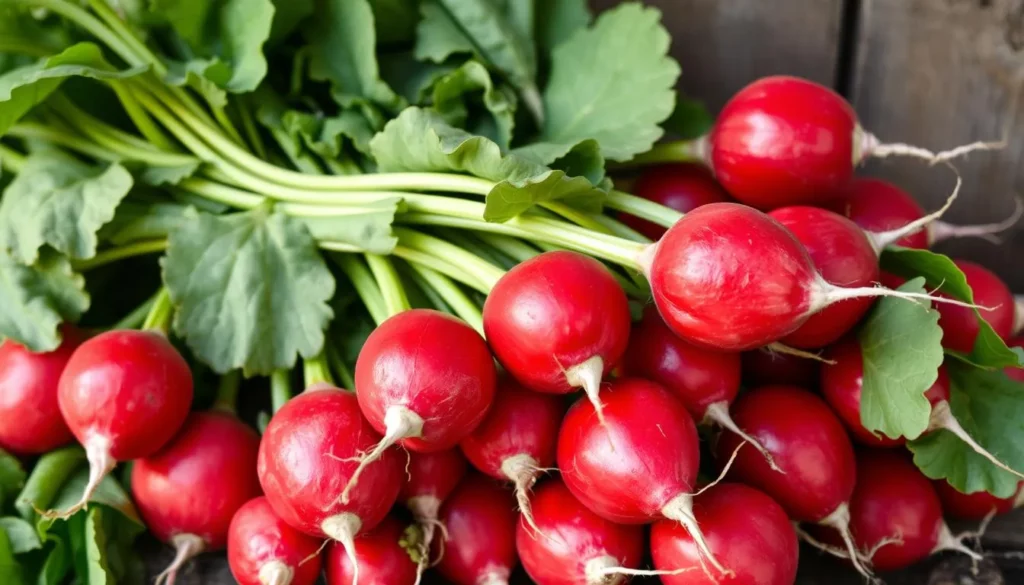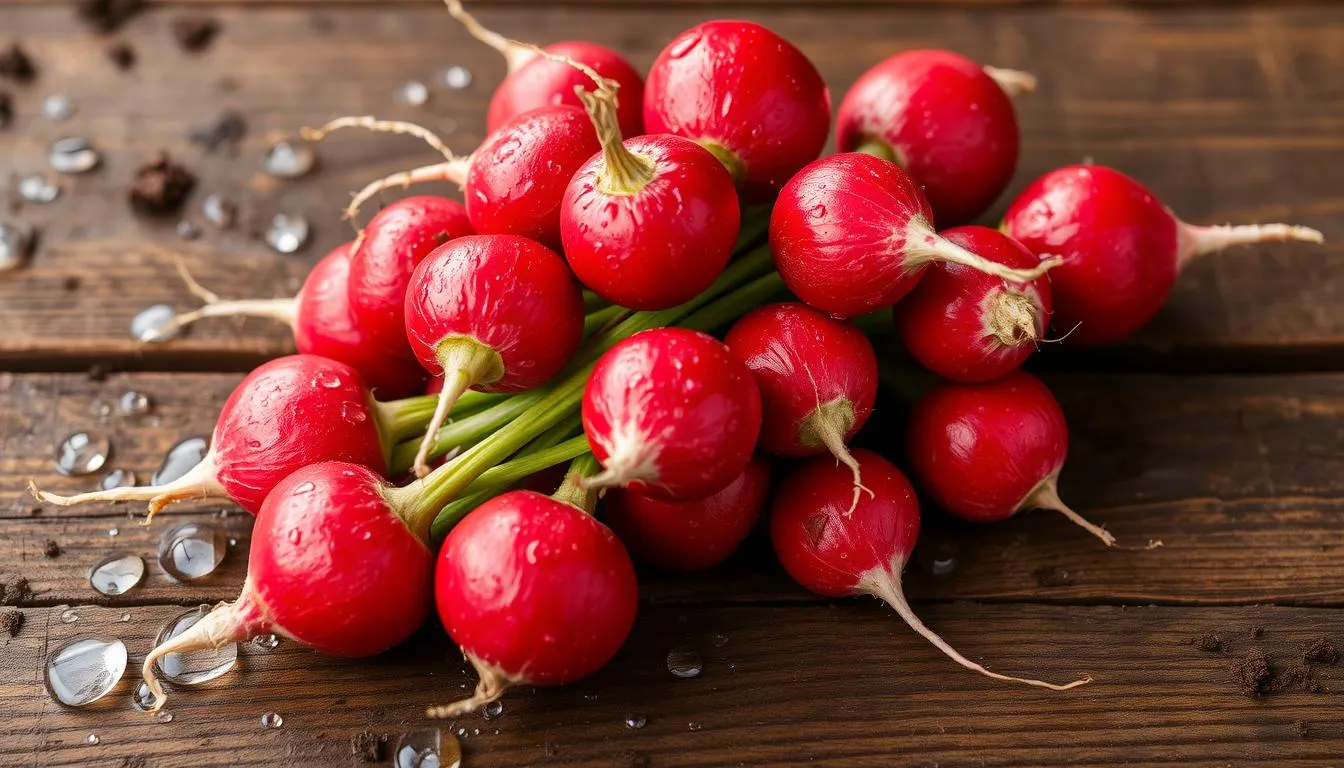Fresh radishes are a great addition to many meals. They add a nice crunch and a zesty flavor. But sometimes, they can taste muddy or earthy, which isn’t good.
If you’ve had this problem, don’t worry. This guide will show you how to get rid of the muddy taste. You’ll be able to enjoy radishes’ true flavors again.
Understanding Why Radishes Can Taste Muddy
Radishes have a unique taste that can sometimes feel muddy or muted. This can be a turn-off for some. To get to the bottom of this, we need to explore the science behind radish flavors.
The Science Behind Earthy Flavors in Root Vegetables
Thiocyanates are the main culprits behind radish’s earthy taste. These sulfur compounds help protect the plant from pests and diseases. However, they can make radishes taste strong and unpleasant if there’s too much of them.
Common Causes of Muddy Taste in Radishes
- Too much rain or watering can make radishes produce more thiocyanates.
- Soil that lacks nutrients can stress radishes, leading to more thiocyanates.
- Some radish types naturally have more of these compounds.
Soil Quality and Its Impact on Radish Flavor
The soil where radishes grow affects their taste. Radishes in rich, well-draining soil taste peppery and vibrant. But those in poor soil taste earthy and muted. Good soil quality and nutrients are key for a great radish taste.

Best Practices for Selecting Fresh Radishes at the Store
Choosing the best radishes at the grocery store is important. Look for visual cues and quality to get the freshest radishes. This ensures your dishes will be delicious.
Start by checking the radishes’ appearance. They should have vibrant, crisp skin without blemishes. The tops should be green and fresh, not wilted. Avoid radishes that look dull or shriveled.
- Check the texture of the radishes. They should feel heavy and firm, with no soft spots.
- Choose medium-sized radishes. They have the best flavor and texture.
- Look for bright, vibrant colors. Red or white is best, depending on the variety.
By picking the freshest radishes at the grocery store, you’ll do great in the kitchen. The right radish quality means full flavor and crunch in your dishes.

Essential Cleaning Techniques to Get the Muddy Taste Out of Fresh Radishes
Fresh radishes can sometimes taste muddy. This can ruin their crisp and peppery flavor. Luckily, there are ways to clean them and get rid of the muddy taste.
Cold Water Soaking Method
Soaking radishes in cold water for 15-30 minutes is a simple fix. It loosens dirt and debris, making it easy to rinse away. Make sure to change the water a few times for the best results.
Vinegar Solution Treatment
For a deeper clean, try a vinegar solution. Mix one part white vinegar with three parts water. Soak the clean radishes in it for 5-10 minutes. The vinegar’s acidity breaks down dirt and removes muddy tastes. Rinse them well with fresh water after.
Salt Scrubbing Technique
- Use coarse salt to scrub stubborn dirt or debris off clean radishes.
- Make a paste with a tablespoon of salt and a few drops of water.
- Rub the paste over the radish, then rinse well.
- This method also helps remove dirt and soaking vegetables.
By using these cleaning techniques, you can enjoy radishes’ bright, peppery flavor without the muddy taste.
Proper Storage Methods to Maintain Fresh Radish Flavor
Keeping radishes fresh is key to enjoying their bright taste. The right storage methods are crucial for keeping these root veggies in top shape. Let’s look at the best ways to store radishes and keep them fresh.
Keeping radishes cool and humid is essential. This helps them stay crisp and prevents them from wilting. Place radishes in the crisper drawer of your fridge. This area has the right temperature and moisture for them.
Trimming the greens and storing radish roots in a sealed bag or container works well. Add a bit of water to keep them hydrated. Don’t forget to change the water every few days for the best vegetable storage.
| Storage Method | Benefits |
|---|---|
| Refrigerator Crisper Drawer | Maintains cool, humid environment to preserve freshness |
| Sealed Bag or Container with Water | Keeps radishes hydrated and prevents drying out |
By using these simple storage methods, your radishes will stay fresh and tasty. Proper refrigeration and keeping them hydrated are the secrets to preserving their freshness.
Pre-Preparation Tips for Removing Unwanted Tastes
Before you start enjoying radishes, it’s key to know a few important steps. These steps help get rid of any bad tastes. You’ll learn about trimming and peeling, the good of blanching, and the coolness of an ice bath. These easy steps can make even the toughest radishes crisp and refreshing for your meals.
Trimming and Peeling Techniques
First, trim the radish ends and remove any bad spots. This makes your radishes look better and taste better too. If the skin is tough, peel it off to reveal the tasty inside.
Quick Blanching Method
For better flavor and crunch, try quick blanching. Boil water, then dip the radishes in for 30 seconds. This step softens any bad tastes but keeps the radish crunchy.
Ice Bath Benefits
After blanching, put the radishes in an ice bath. This quick cool-down keeps the radishes colorful and crunchy. It makes sure they stay fresh and tasty while you cook.
| Pre-Preparation Technique | Benefits |
|---|---|
| Trimming and Peeling | Removes concentrated areas of undesirable flavors and improves appearance |
| Quick Blanching | Mellows out lingering muddy notes while preserving crunch |
| Ice Bath | Locks in vibrant color and crisp texture |
By using these simple steps, you can make radishes ready for use. You’ll learn to prepare radishes, trim vegetables, and use blanching and ice bath to keep them fresh. Your radishes will be crisp, fresh, and free of bad tastes.
Cooking Methods That Enhance Radish Flavor
Choosing the right cooking method can really make fresh radishes shine. Try roasting, sautéing, and grilling to bring out their vibrant, peppery taste. These methods help reduce muddy flavors and highlight radishes’ unique charm.
Roasting: Caramelized Perfection
Roasting radishes at high heat is a game-changer. The dry heat caramelizes their sugars, blending their peppery taste with a sweet, nutty flavor. Simply toss the cook radishes with olive oil, salt, and herbs, then roast until they’re golden.
Sautéing: Quick and Flavorful
Sautéing radishes is quick and easy. It keeps their crunch while adding a subtle flavor. Cook them in butter or oil with salt, pepper, and spices. This method preserves their crisp bite.
Grilling: Smoky, Charred Goodness
Want a smoky, charred radish flavor? Fire up the grill! Grilling vegetables like radishes caramelizes their sugars, adding a sweet note. Toss them in oil, salt, and seasonings, then grill until tender and charred.
Try these cooking methods to enhance your radish’s flavor. With a bit of creativity, you can turn these simple root vegetables into a flavorful delight.
Natural Ingredients That Neutralize Earthy Tastes
Radishes can sometimes taste muddy. But, there are natural ways to fix this. Zesty citrus, aromatic herbs, and seasonings can change radish taste for the better.
Citrus Solutions
Citrus fruits like lemon and lime juice can balance radish flavor. Adding a squeeze of fresh citrus can make a big difference. You can also use the zest for more citrus flavor.
Herb Combinations
- Fragrant herbs like mint, cilantro, or parsley can refresh radish taste.
- Woody herbs such as thyme, rosemary, or oregano add savory depth.
Seasoning Options
Some seasonings can also improve radish taste. Sea salt or a drizzle of olive oil can highlight radish sweetness.
| Ingredient | Effect on Radish Flavor |
|---|---|
| Lemon juice | Adds brightness and acidity to counteract earthiness |
| Mint | Provides a refreshing, cooling contrast to pungent notes |
| Olive oil | Enhances the natural sweetness and balances out bitterness |
Using these natural flavor pairings can make radishes taste better. You’ll enjoy their crisp, peppery flavor without any earthy taste.
Common Mistakes to Avoid When Preparing Radishes
Preparing radishes can be fun, but even experts make mistakes. These errors can make radishes taste muddy. Knowing these mistakes helps your radishes stay crisp and peppery.
One big radish preparation error is not cleaning them well. Radishes can pick up dirt, making them taste earthy. Washing them under cold water and soaking them helps get rid of dirt.
Another cooking mistake is cooking radishes too long. Cooking them too much makes them mushy and loses their crunch. Use quick methods like sautéing or roasting to keep them crunchy.
Also, not removing the green tops is a mistake. These leaves can make radishes taste bitter. So, always trim them off before cooking or serving.
Remember these tips to make your radishes taste great. Avoiding these mistakes ensures your radishes are flavorful and not muddy.
Conclusion
Removing the muddy taste from radishes is possible with the right steps. You need to pick the right radishes, clean them well, and prepare them smartly. Knowing why radishes taste earthy helps you fix the problem.
Choosing radishes wisely and cleaning them properly are key. Soaking in cold water and using vinegar can help. Also, trimming, peeling, and blanching before cooking can make a big difference. Adding citrus, herbs, and the right seasonings can also get rid of bad tastes.
By following these tips, you can always have radishes that taste great. They will make your food better and add joy to your meals. Focus on making radishes taste better, and you’ll enjoy this tasty vegetable even more.
FAQ
What causes the muddy taste in fresh radishes?
Fresh radishes get a muddy taste from the soil they grow in. They soak up the earthy flavors and minerals. This can make them taste unpleasantly muddy.
How can I select the freshest radishes at the grocery store?
Choose radishes that are firm and crisp. Make sure they don’t have any blemishes. Stay away from wilted or soft radishes with discolored skin. They might taste more muddy.
What are some effective techniques for removing the muddy taste from fresh radishes?
Soaking radishes in cold water can help. You can also use a vinegar solution or gently scrub them with salt. These methods remove dirt and impurities that cause the muddy taste.
How should I store radishes to maintain their fresh flavor?
Store radishes in the fridge in a sealed container or plastic bag. This keeps them crisp and prevents off-flavors from developing.
What cooking methods can help enhance the flavor of radishes?
Roasting, sautéing, or grilling radishes can make them sweeter. Pairing them with citrus, herbs, and spices also balances their flavor. This makes them taste better.





